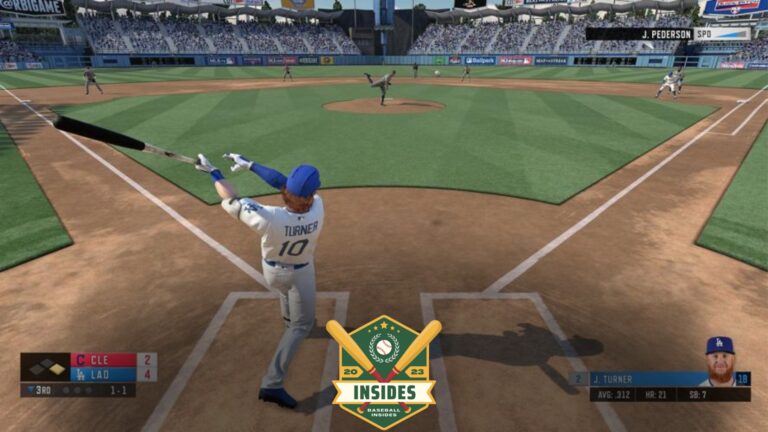
In this article:
Ever watched a thrilling baseball game that ended with a swing of the bat, sending the crowd into a frenzy of excitement? Chances are, you’ve witnessed a Walkoff. But what exactly is a walkoff in baseball? Let’s dive right into it.
In its simplest terms, a walkoff refers to the end of the game caused by the home team scoring the winning run in the last inning. The term “walkoff” implies that the losing team, typically the visiting team, has to “walk off” the field after the home team’s victory.
Definition and Origin
Let’s start by answering the basic question: What is a walk-off in baseball? In its essence, a walk-off refers to the end of a baseball game, decided by the home team in the last half of the innings.
This could be the bottom of the ninth inning or any extra inning, provided the game is tied. Essentially, it’s the joyous moment when the home team wins the game on their final turn at bat.
Any play that results in the home team scoring the winning run can be a walk-off. It could be a home run, a hit that drives in a run, a walk with the bases loaded, or even an error by the opposing team that allows the winning run to score.
The home team must score the winning run while they’re at bat, ending the game immediately.
Now, you might wonder where the term “walk-off” came from. The term is credited to Dennis Eckersley, a former Major League Baseball pitcher.
Eckersley began using “walk-off” during the late 1980s and early 1990s to describe the rather disappointing act of a pitcher having to “walk off” the field after losing the game.
Over time, however, the term has evolved to focus more on the winning team’s celebration than the losing pitcher’s dejection.
Interestingly, the term “walk-off” is relatively new in the long history of baseball. It has become a part of the modern baseball lexicon, encapsulating the sudden-death nature of a tightly contested game and the exhilaration of an unexpected victory.
Its usage has grown over the years, adding another layer of excitement and drama to the sport we love.
Types of Walk-offs
- List and explain how a walk-off can occur (e.g., hit, error, walk with bases loaded, etc.).
- Provide real-life examples for each type.
Types of Walk-offs
There are numerous ways a walk-off can occur in baseball. The beauty of this sport lies in its unpredictability, and a walk-off further adds to this excitement. Here are some common scenarios where a walk-off can happen:
- Walk-off Hit: This is the most common type of walk-off. It occurs when a batter hits the ball in such a way that the runner on base can score. The game ends immediately as this run gives the home team the lead. A classic example is the 1993 World Series game where Joe Carter of the Toronto Blue Jays hit a walk-off home run, winning the series for his team.
- Walk-off Error: Here, the home team wins due to a defensive error by the opposition. This might be a missed catch or an errant throw that allows the winning run to score. Game 6 of the 1986 World Series is an infamous example. Bill Buckner of the Boston Red Sox made a crucial fielding error, enabling Ray Knight of the New York Mets to score the winning run.
- Walk-off Walk: This type of walk-off occurs when the bases are loaded and the pitcher walks the batter, forcing in the winning run. An example of a walk-off walk is the New York Yankees and the Seattle Mariners game in July 2016. In the bottom of the ninth, the Yankees’ Mark Teixeira was walked with the bases loaded, ending the game.
These are just a few of the ways a walk-off can occur, each bringing its own unique thrill to the game of baseball.
Before diving into the excitement of walkoffs, it’s important to understand some basic rules that can affect the game’s outcome, such as what is a balk in baseball and how it can shift the momentum.
Strategy and Tactics
In baseball, managing a potential walk-off situation requires keen strategic thinking from the home and visiting teams. While the home team is looking to score, the visiting team is focused on preventing the run to survive another inning. Let’s delve into their respective tactics.
Home Team Strategy
The home team’s primary goal is to get a runner on base and subsequently advance them to scoring positions. This often involves a combination of strategic batting and base running.
The batter’s job is to hit the ball effectively and choose pitches that allow them to control where the ball goes. This could mean targeting a hit to exploit a gap in the field or even intentionally bunting to advance a runner.
Aggressive base running can also be critical in a potential walk-off situation. The runner must be ready to exploit any defensive errors, taking the extra base whenever possible.
The goal is to get as close to home plate as possible, ideally leaving only a short sprint to score the winning run.
Visiting Team Strategy
Conversely, the visiting team’s defense is focused on preventing any runner from reaching home plate. This involves both the pitcher and the fielders playing their parts effectively.
The pitcher must limit the batter’s ability to control the ball, striking them out or forcing them to make weak contact. This could involve pitch selection or location change, aiming to keep the batter off balance.
Meanwhile, the fielders must be ready to react swiftly to any hit. This could involve positioning themselves to cover potential gaps or even playing closer to the home plate to reduce the runner’s chances of scoring on a hit.
In some cases, the defense may even employ a shift, where fielders move from their usual positions to areas where the batter is most likely to hit the ball. This is all to stop the runner at home plate and extend their survival in the game.
In the postseason, where walkoffs become even more legendary, understanding the structure of the playoffs, including what does ALCS stand for in baseball, is essential for appreciating the high stakes of these moments.
Emotional and Cultural Impact
Home Team Celebration
When a walk-off occurs, it’s a cause for jubilation by the home team. The moment the winning run crosses the plate, the dugout empties, and teammates rush onto the field to celebrate.
It’s a moment of spontaneous joy and enthusiastic cheer, often characterized by high-fives, fist bumps, and, in some cases, playful antics like dousing the walk-off hero with water or shaving cream. The crowd typically joins in this celebration, cheering throughout the stadium.
Emotional Impact on the Teams
The emotional impact of a walk-off is profound, both for the winning and losing teams. For the winning team, it’s a surge of joy, a stark turnaround from the tension that leads up to the moment.
A walk-off empowers the team, boosting morale and fueling belief in their collective abilities. It’s a reminder of the unpredictable nature of baseball, where the game is never over until the last out.
On the other side, the losing team experiences the exact opposite. The sudden shift from a competitive situation to an immediate loss can be shocking and demoralizing.
It’s a harsh reminder of the thin line between victory and defeat in baseball. Yet, it is a poignant lesson that every pitch, every swing, and every play matters in the game.
Famous Walk-off Moments
The magic of a walk-off in baseball is that it can turn an ordinary game into a historical event.
These instances have been etched deep in the annals of baseball, creating unforgettable moments that have defined careers, shaped rivalries, and captured the hearts of fans worldwide.
Here are some of the most famous walk-off moments in baseball history:
- Bill Mazeroski’s 1960 World Series Home Run: In game 7 of the 1960 World Series, Bill Mazeroski hit a walk-off home run to give the Pittsburgh Pirates their first championship since 1925. This monumental hit is still the only walk-off home run in Game 7 of a World Series.
- Kirk Gibson’s 1988 World Series Home Run: Despite nursing injuries in both legs, Kirk Gibson hit a surprising two-run home run in the bottom of the ninth inning of Game 1 in the 1988 World Series. His iconic fist-pumping run around the bases is one of the most enduring images in baseball history.
- Joe Carter’s 1993 World Series Home Run: Joe Carter’s three-run home run in the ninth inning of Game 6 in the 1993 World Series clinched the championship for the Toronto Blue Jays. His ecstatic leap around the bases has become an iconic moment in the sport.
While discussing walkoffs, it’s also fascinating to explore the pitchers’ side of the game, particularly what does ERA mean in baseball, as it helps gauge a pitcher’s effectiveness, which can be crucial in late-game situations.
Emotional Impact on the Teams
Walk-offs have a profound emotional impact on both the winning and losing teams. For the victorious team, it’s a moment of collective triumph that can boost morale and confidence.
The excitement, joy, and relief of a walk-off can often propel a team forward in a season, creating a momentum shift that can last for games or weeks.
Conversely, a walk-off loss can be devastating for the visiting team. It’s a sudden, dramatic defeat that can shatter confidence and morale.
These memorable moments have anchored themselves in the minds of the players involved and have left a lasting impact on the sport itself.
They have become iconic snapshots, capturing the drama, unpredictability, and emotional intensity that make baseball a beloved game.
The Importance of Timing in a Walkoff
In baseball, timing is everything, and nowhere is this more evident than in a walkoff. The essence of a walkoff lies in its timing. It’s not just about scoring but about when that score is made.
A perfectly timed hit, run, or home run can turn a game around and leave an indelible mark on the players and spectators.
The walkoff moment occurs in the bottom of the final inning, typically the ninth inning or later in case of a tied game.
The home team has the last opportunity to bat, and if they manage to score and take the lead, the game ends right there. This is what makes the timing so crucial.
The Pressure of the Clock
Unlike many other sports, baseball has no running game clock that dictates the game’s length. Instead, the game continues until several outs have been achieved. However, the ticking internal clock of a walkoff situation adds unique pressure.
The batter knows this could be the final chance to change the game’s outcome. The pressure to perform and make every second count is immense.
The Element of Surprise
Another reason timing is so important in a walkoff is the element of surprise. The opposing team might be leading the game until the very last inning. But a well-timed hit or home run can flip the game, giving the home team the win.
This sudden change can be a powerful psychological blow to the visiting team while simultaneously triggering a euphoric celebration for the home team and its fans.
Crucial Decision Making
Timing also plays a critical role in decision-making during a walkoff situation. Should the batter aim for a single hit to get on base or go for a home run to win the game outright?
Should the pitcher throw a risky strike to get the batter out or play it safe? These decisions, made in the heat of the moment, can drastically affect the game’s outcome.
Walkoffs in Different Baseball Leagues and Tournaments
Baseball leagues and tournaments worldwide feature a wealth of walk-off moments that add an exciting element to the game.
Let’s examine how walkoffs occur in various domestic and international baseball settings.
Major League Baseball (MLB)
In the Major League Baseball (MLB) of the United States, the walkoff has become a cherished part of the game’s lore. It’s most commonly seen in extra innings when the home team has the last opportunity to bat.
However, it can also occur in the ninth inning if the score is tied or the home team is trailing by a run or two. Given the competitive nature of MLB, walk-offs often result in unforgettable moments and thrilling victories.
Nippon Professional Baseball (NPB)
Japan’s Nippon Professional Baseball (NPB) also recognizes walk-offs, although with a twist.
In NPB, if a game is tied after 12 innings, it’s declared a tie, meaning the opportunities for a walkoff are limited to regulation innings and the first three extra innings.
Nonetheless, the limited opportunities make every potential walkoff moment highly suspenseful.
Little League Baseball
In Little League Baseball, walkoffs are equally dramatic and carry significant importance. These moments are particularly thrilling because they often represent a young player’s first taste of high-stakes baseball.
A walkoff can be a defining moment in their early baseball career, setting them on a path to pursue the sport at a higher level.
World Series and Playoff Games
Walkoffs become even more critical and celebrated postseason, particularly during the World Series and playoff games. These high-pressure situations enhance the drama of potential walkoff scenarios.
A single walkoff home run or hit can turn the tide of a series and cement a player’s place in baseball history.
International Tournaments
Walkoffs aren’t restricted to domestic leagues; they’re also a part of international tournaments like the World Baseball Classic and the Olympic Games.
Here, representing one’s country adds another layer of intensity to the potential walkoff moment. These games can end in a walkoff, creating an unforgettable experience for players and fans.
As you can see, walk-offs add an element of suspense, drama, and excitement to baseball games across various leagues and tournaments. They are the moments players dream of, and fans look forward to, making the beautiful baseball game special.
Conclusion
In conclusion, a walkoff is used in baseball to describe a situation where the home team wins the game in the last inning, causing the visiting team to ‘walk off’ the field. It’s a thrilling moment that characterizes the unpredictability and excitement of the sport.
While the term ‘walkoff’ is most commonly associated with home runs, it’s worth noting that any offensive play that results in the home team taking the lead in the bottom of the final inning can be considered a walkoff. It could be a base hit, a sacrifice fly, or a wild pitch.
The significance of a walkoff goes beyond just the score. For the home team, it’s a moment of euphoria and triumph.
For the fans, it’s a memory that could last a lifetime. And for the sport of baseball, it’s a testament to the drama and spectacle that makes every game a unique event.
Key Takeaways
- A walkoff occurs when the home team wins in the last inning, causing the visiting team to leave the field immediately.
- While most often associated with home runs, a walkoff can result from any offensive play that gives the home team the lead.
- The term ‘walkoff’ encompasses baseball’s excitement, unpredictability, and dramatic nature.
Frequently Asked Questions
What is a walkoff grand slam?
A walk-off grand slam is a grand slam home run hit by the home team in the bottom of the last inning to win the game.
How does a hit-by-pitch result in a walkoff?
If the bases are loaded, and a pitch hits a batter, the runner on third base can walk home, resulting in a walkoff.
What is a game-winning home run?
A game-winning home run is a home run hit by a player that scores the go-ahead run in the bottom of the last inning, leading their team to victory.
When is a hit a walkoff hit?
A hit is considered a walkoff if the winning run is scored by the home team in the bottom of the last inning.
Can a passed ball lead to a walkoff?
Yes, if a runner on third base and a passed ball allows them to score the go-ahead run in the bottom of the last inning, it can result in a walkoff.
What is a game-winning run?
A game-winning run is the run that gives the home team the lead in the bottom of the last inning, resulting in a walkoff victory if the opposing team cannot score in their half of the inning.
What happens when the home team scores the go-ahead run in the bottom of the last inning?
When the home team scores the go-ahead run in the bottom of the last inning, it is called a walkoff win because the game ends immediately after.
What is a walkoff piece?
A walkoff piece refers to any hit or play that results in the winning run being scored and the game ending in favor of the home team.
What does a walkoff RBI mean?
A walkoff RBI (Run Batted In) refers to a run scored by the home team in the bottom of the last inning, resulting in a walkoff victory.






